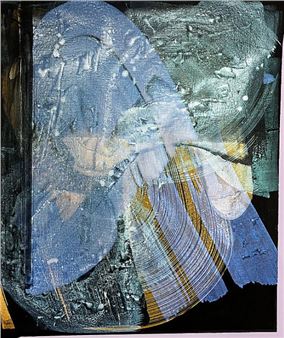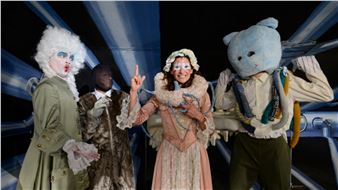Rom├йo Mivekannin: Spleen
For this yearтАЩs Gallery Weekend, Galerie Barbara Thumm presents тАЬSpleen,тАЭ an exhibition featuring a striking series of paintings by Rom├йo Mivekannin (*1986, Bouak├й, C├┤te dтАЩIvoire). Known for his unique reinterpretations of canonical European artworks, Mivekannin draws upon a vast colonial visual archiveтАФfrom 18th- to 19th-century Orientalist paintings to early colonial photographyтАФto interrogate and subvert historical representations of otherness, power, and desire.
MivekanninтАЩs second solo show at Galerie Barbara Thumm revisits the history of Orientalism with a bold intervention in the original paintings that he uses for inspiration. Presented as free-hanging canvases, his paintings do not merely reference the Orientalist tradition; they irritate it. In a subversive act, which Mivekannin refers to as тАЬvisual irritationтАЭ, he reinterprets the original paintings or photographs and replaces the subjectsтАЩ faces with his own black- and-white portrait, looking directly at the viewer. This direct gaze transforms the viewers into active participants and reclaims agency for the figures once rendered as dominated subjects, exposing the power dynamics embedded within the works. His approach, rooted in an act of critical reappropriation, turns Orientalism onto itself to reconsider its legacy in a contemporary context, as part of a collective healing process. His canvases, crafted from old bedsheets and infused with elixir baths inspired by voodoo rituals from Benin (where MivekanninтАЩs family is from), carry profound spiritual and ancestral resonance.
In his seminal book тАЬOrientalism,тАЭ (1978) Edward Said conceptualized the term as a European invention in which the West (particularly France and Britain) created an imaginary vision and understanding of the тАЬOrientтАЭ shaped by a discourse of power and domination. Artists, writers, and academics fabricated an image of this тАЬOrientтАЭ and its inhabitants that was both romanticized and objectified, reducing diverse cultures and realities to a set of stereotypes that often served colonial ideologies. The notions of fabrication and invention are key in Orientalism; The term тАЬarmchair orientalistsтАЭ referred to the many scholars or writers who never traveled to the places they wrote about but, instead, created their works describing remote lands based on the accounts of others and their own imagination. The same happened with many Orientalist artists who did not leave their studios in Paris or elsewhere in Europe and from there painted a myriad of scenes using photographs, textiles, and literature as inspiration. Even though some of these artists or writers indeed traveled to places like Constantinople, Algeria, or the Levant, even settling there at some point, many of them used the garments and objects collected on their travels as props to shape their paintings from their studios. In some cases, they even used European models, especially considering that it was unlikely that male painters were allowed to enter the very intimate spaces they portrayed in their works that included nude women.
In тАЬSpleenтАЭ Mivekannin reexamines the works of European painters like Jean-L├йon G├йr├┤me, Jean-├Йtienne Liotard, and ├Йdouard Debat-Ponsan, among others, who depicted the тАЬOrientтАЭ through highly theatricalized scenesтАФharems, hammams, and other imagined settingsтАФportraying women and subjects as eroticized objects of desire or symbols of subjugation. Much of these scenes present a supposed depiction of everyday life and others focus on domestic settings, with a strong emphasis on female nude subjects in intimate spaces on the latter. By engaging in an act of тАЬcitationтАЭ or тАЬvisual referencing,тАЭ Mivekannin meticulously reinterprets the ornate details of the original paintings, including their references to Islamic architecture, geometric patterns, floral motifs, and sumptuous textiles, and also includes the figures depicted in the scenes (mostly female). His titles always bear the term тАЬAfterтАЭ, followed by the original artistтАЩs name and the workтАЩs title, emphasizing the inspiration for MivekanninтАЩs paintings but also making it clear that it тАЬfollowsтАЭ the original and is not the same. For instance, in тАЬAfter Debat-Ponsan, Le massage,тАЭ Mivekannin recreates a very intimate scene of a hammam in which a white woman lies on her front, while a black woman massages her arm. The scene portrays an implicit power relation with the black woman as the servant to the white one, further reinforcing colonial imaginary. Both female figures are completely and partially nude, adding an element of voyeurism to the scene from the male gaze, especially in a setting where men were not allowed.

Recommended for you
For this yearтАЩs Gallery Weekend, Galerie Barbara Thumm presents тАЬSpleen,тАЭ an exhibition featuring a striking series of paintings by Rom├йo Mivekannin (*1986, Bouak├й, C├┤te dтАЩIvoire). Known for his unique reinterpretations of canonical European artworks, Mivekannin draws upon a vast colonial visual archiveтАФfrom 18th- to 19th-century Orientalist paintings to early colonial photographyтАФto interrogate and subvert historical representations of otherness, power, and desire.
MivekanninтАЩs second solo show at Galerie Barbara Thumm revisits the history of Orientalism with a bold intervention in the original paintings that he uses for inspiration. Presented as free-hanging canvases, his paintings do not merely reference the Orientalist tradition; they irritate it. In a subversive act, which Mivekannin refers to as тАЬvisual irritationтАЭ, he reinterprets the original paintings or photographs and replaces the subjectsтАЩ faces with his own black- and-white portrait, looking directly at the viewer. This direct gaze transforms the viewers into active participants and reclaims agency for the figures once rendered as dominated subjects, exposing the power dynamics embedded within the works. His approach, rooted in an act of critical reappropriation, turns Orientalism onto itself to reconsider its legacy in a contemporary context, as part of a collective healing process. His canvases, crafted from old bedsheets and infused with elixir baths inspired by voodoo rituals from Benin (where MivekanninтАЩs family is from), carry profound spiritual and ancestral resonance.
In his seminal book тАЬOrientalism,тАЭ (1978) Edward Said conceptualized the term as a European invention in which the West (particularly France and Britain) created an imaginary vision and understanding of the тАЬOrientтАЭ shaped by a discourse of power and domination. Artists, writers, and academics fabricated an image of this тАЬOrientтАЭ and its inhabitants that was both romanticized and objectified, reducing diverse cultures and realities to a set of stereotypes that often served colonial ideologies. The notions of fabrication and invention are key in Orientalism; The term тАЬarmchair orientalistsтАЭ referred to the many scholars or writers who never traveled to the places they wrote about but, instead, created their works describing remote lands based on the accounts of others and their own imagination. The same happened with many Orientalist artists who did not leave their studios in Paris or elsewhere in Europe and from there painted a myriad of scenes using photographs, textiles, and literature as inspiration. Even though some of these artists or writers indeed traveled to places like Constantinople, Algeria, or the Levant, even settling there at some point, many of them used the garments and objects collected on their travels as props to shape their paintings from their studios. In some cases, they even used European models, especially considering that it was unlikely that male painters were allowed to enter the very intimate spaces they portrayed in their works that included nude women.
In тАЬSpleenтАЭ Mivekannin reexamines the works of European painters like Jean-L├йon G├йr├┤me, Jean-├Йtienne Liotard, and ├Йdouard Debat-Ponsan, among others, who depicted the тАЬOrientтАЭ through highly theatricalized scenesтАФharems, hammams, and other imagined settingsтАФportraying women and subjects as eroticized objects of desire or symbols of subjugation. Much of these scenes present a supposed depiction of everyday life and others focus on domestic settings, with a strong emphasis on female nude subjects in intimate spaces on the latter. By engaging in an act of тАЬcitationтАЭ or тАЬvisual referencing,тАЭ Mivekannin meticulously reinterprets the ornate details of the original paintings, including their references to Islamic architecture, geometric patterns, floral motifs, and sumptuous textiles, and also includes the figures depicted in the scenes (mostly female). His titles always bear the term тАЬAfterтАЭ, followed by the original artistтАЩs name and the workтАЩs title, emphasizing the inspiration for MivekanninтАЩs paintings but also making it clear that it тАЬfollowsтАЭ the original and is not the same. For instance, in тАЬAfter Debat-Ponsan, Le massage,тАЭ Mivekannin recreates a very intimate scene of a hammam in which a white woman lies on her front, while a black woman massages her arm. The scene portrays an implicit power relation with the black woman as the servant to the white one, further reinforcing colonial imaginary. Both female figures are completely and partially nude, adding an element of voyeurism to the scene from the male gaze, especially in a setting where men were not allowed.
Artists on show
Contact details

Related articles
For this yearтАЩs Gallery Weekend, Galerie Barbara Thumm presents тАЬSpleen,тАЭ an exhibition featuring a striking series of paintings by Rom├йo Mivekannin (b. 1986, Bouak├й, C├┤te dтАШIvoire).
To wander Kreuzberg during this yearтАЩs Gallery Weekend is to surrender to a d├йrive of some sort.














